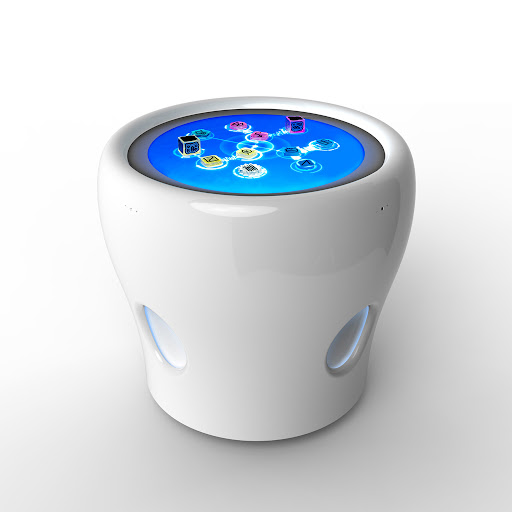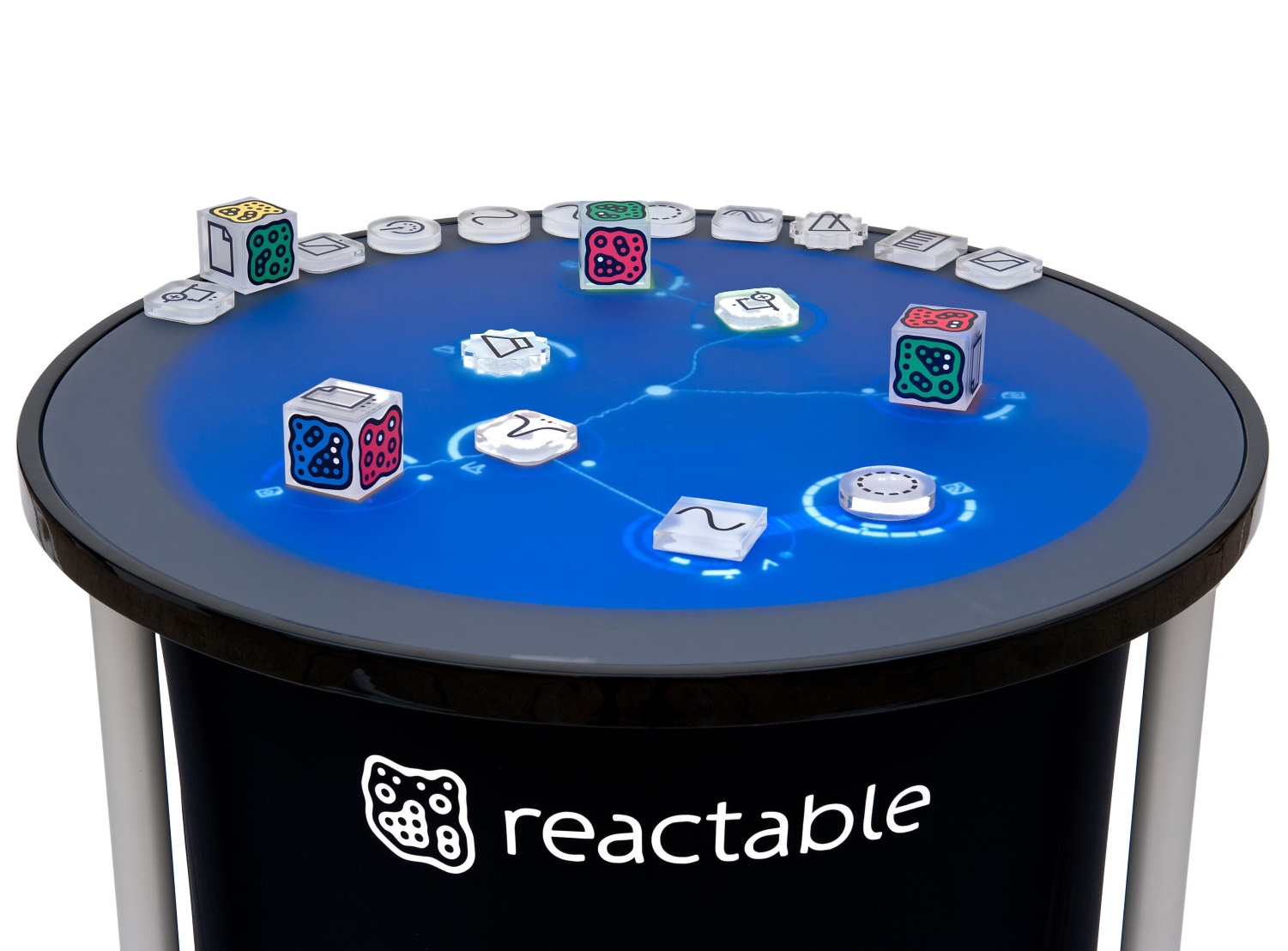Reactable
Electronic Instruments
Europe
Between 1901 and present
Video
The Reactable is an interactive electronic musical instrument that combines tangible user interface (TUI) technology with digital sound processing. It allows users to manipulate physical objects on a translucent, backlit tabletop surface, creating and modifying music in real-time. By moving and rotating these objects, musicians can generate loops, effects, synthesizer sounds, and other sonic elements. The Reactable is widely recognized for its futuristic design, intuitive control, and visual appeal, making it a popular choice among electronic musicians, DJs, and performers.
Type of Instrument
The Reactable falls under the category of electronic musical instruments and, more specifically, digital synthesizers. Unlike traditional synthesizers that rely on knobs, sliders, and keys, the Reactable employs a hands-on, gesture-based approach. It is closely associated with experimental and interactive music and serves as both a performance instrument and an educational tool for exploring sound synthesis.
History of the Reactable
Origin and Development
The Reactable was developed in the early 21st century, specifically in the 2000s, by a research team at the Universitat Pompeu Fabra in Barcelona, Spain. The team, led by Sergi Jordà, Martin Kaltenbrunner, Günter Geiger, and Marcos Alonso, aimed to create a collaborative and intuitive music-making system that blended the physical and digital worlds.
Unlike traditional electronic instruments, which often require deep technical knowledge, the Reactable was designed to be accessible to musicians of all skill levels. Since its public introduction, it has gained global recognition and has been used by high-profile artists such as Björk, who featured it in her live performances.
Evolution and Impact
The Reactable has evolved significantly since its inception. Initially a research prototype, it transitioned into a commercially available product, including versions for professional musicians, educational institutions, and even tablet applications for iOS and Android devices. Over the years, its unique design and interactive capabilities have influenced the development of newer music technology and inspired other tangible musical interfaces.
Construction and Design
Physical Structure
The Reactable consists of a circular tabletop embedded with a touch-sensitive surface and a projection system underneath. The system works by tracking the position, orientation, and movement of tangible objects called pucks, which represent different sound modules such as:
Oscillators – Generate waveforms for sound synthesis.
Effects – Modify the sound through filters, delays, reverbs, and distortions.
Sequencers – Control rhythm and pattern generation.
Controllers – Adjust parameters such as pitch, volume, and modulation.
Software and Digital Integration
The Reactable uses computer vision technology to detect and interpret the movement of pucks. A camera positioned beneath the table captures real-time data, which is processed using specialized software. The visual feedback, displayed on the tabletop, provides an immersive and engaging interface for musicians.
Types of Reactable
There are several versions of the Reactable designed for different use cases:
Reactable Live – A professional performance instrument for musicians and DJs.
Reactable Experience – An educational and museum-oriented version for interactive exhibitions.
Reactable Mobile – A software-based version available for smartphones and tablets.
Each version retains the core functionality of the original but is optimized for its respective platform.
Features of the Reactable
The Reactable is an innovative electronic musical instrument that combines tangible user interface (TUI) technology with digital sound synthesis, allowing users to create and manipulate music in an interactive way. It consists of a round, illuminated tabletop surface where users place and move physical objects, called pucks, to control different aspects of sound generation, such as pitch, effects, filters, and loops. The table uses a camera-based tracking system beneath the surface to detect the position, rotation, and proximity of these objects, translating their movements into real-time sound modulation. With its intuitive and collaborative design, the Reactable is often used in live performances, music production, and educational settings, enabling both professional musicians and beginners to experiment with electronic music in a hands-on and visually engaging manner.
Sound Production
The Reactable generates sound through digital signal processing (DSP), where different pucks interact to create and modify audio signals. It supports a wide range of synthesis techniques, including:
Subtractive Synthesis – Filtering harmonic content from waveforms.
Additive Synthesis – Combining multiple sine waves.
Granular Synthesis – Manipulating small audio grains.
Sampling and Looping – Using prerecorded sounds.
By altering the placement and rotation of pucks, users can dynamically modify sound parameters, resulting in expressive and evolving musical textures.
Playing Methods
The Reactable is an interactive electronic instrument that uses a touch-sensitive tabletop interface to produce and manipulate sound. Players interact with the Reactable by placing, moving, and rotating physical objects (called “tangible blocks”) on the illuminated surface. Each block represents different sound components, such as oscillators, filters, sequencers, and effects. The system detects their position and movement in real time, visually displaying sound connections through glowing lines and waves. By adjusting the placement and orientation of these blocks, musicians can control parameters like pitch, tempo, modulation, and effects, creating dynamic and evolving soundscapes. Additionally, the Reactable allows for multi-touch gestures, enabling players to modify sound properties directly on the screen. This collaborative and intuitive approach to music-making makes the Reactable a powerful tool for live performances, sound design, and experimental composition.
Role in Music and Significance
The Reactable has had a profound impact on electronic music, live performances, and music education.
Contribution to Music Performance
The Reactable is widely used in experimental and electronic music genres. Its intuitive design allows musicians to create dynamic soundscapes and improvise in real-time, making it an ideal instrument for live performances. Artists like Björk have used it to push the boundaries of visual and auditory expression.
Educational and Research Significance
Beyond entertainment, the Reactable serves as a valuable educational tool. It introduces students to sound design principles, music technology, and interactive computing in an engaging and hands-on manner. Many universities and research institutions use the Reactable to study human-computer interaction (HCI) in music.
Influence on Music Technology
The Reactable has inspired a new generation of touch and gesture-based instruments. Its pioneering approach to tangible user interfaces has influenced developments in digital audio workstations (DAWs), modular synthesizers, and live performance controllers.
The Reactable is a groundbreaking electronic instrument that merges technology, interactivity, and musical creativity. With its unique tangible interface, it has transformed the way musicians engage with sound and performance. Whether in live concerts, educational settings, or experimental music labs, the Reactable continues to be an innovative and influential tool in the world of modern music.
FAQ
What types of instruments does the Reactable resemble?
The Reactable resembles modular synthesizers due to its use of tangible objects representing various audio components like oscillators and filters. Its collaborative nature allows multiple users to create complex audio structures similar to those found in traditional band setups.
What are some key features of the Reactable?
Key features include its tangible user interface for direct interaction with sound modules, real-time visual feedback displaying audio connections, collaborative play capabilities for multiple users, and modular synthesis allowing custom audio configurations.
What materials are used in constructing the Reactable?
The primary material used is a translucent tabletop that houses advanced tracking technology beneath it. Tangibles are typically made from durable materials designed to withstand repeated handling while effectively interacting with the system's tracking mechanisms.
 Links
Links
References
 Similar
Similar
Instruments
Other Instrument
Categories



















